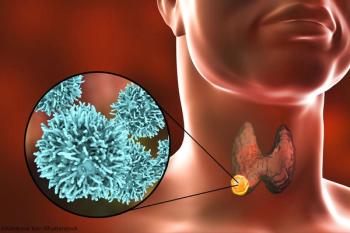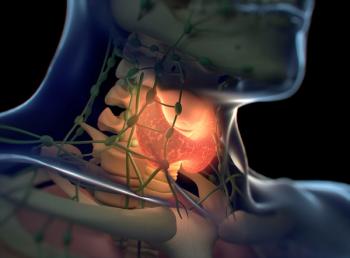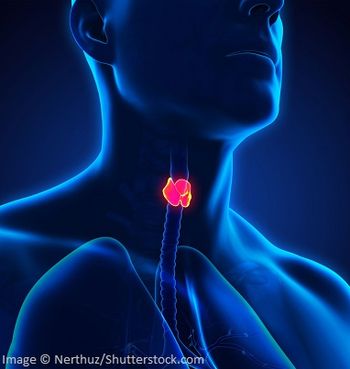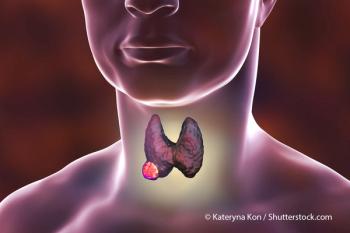
TERT/BRAF Mutations a Deadly Combo for Thyroid Cancer Patients
The coexistence of mutations in telomerase reverse transcriptase (TERT) and BRAF genes dramatically increases the risk of thyroid cancer aggressiveness, tumor recurrence and thyroid cancer-specific deaths.
The coexistence of mutations in telomerase reverse transcriptase (TERT) and BRAF genes dramatically increases the risk of thyroid cancer aggressiveness, tumor recurrence and thyroid cancer-specific deaths, confirmed research teams from the United States and Korea at the 15th International Thyroid Congress (ITC) and 85th Annual Meeting of the American Thyroid Association (ATA) in Lake Buena Vista, Florida.
“BRAF V600E and TERT promoter mutations each alone have a modest effect, but the two coexisting, had a robustly synergistic effect on PTC [papillary thyroid cancer]-specific patient mortality,” reported Mingzhao Xing, MD, PhD, of the division of endocrinology and metabolism at Johns Hopkins University School of Medicine in Baltimore, Maryland.
Dr. Xing, the lead author of the US study, presented preliminary data on the TERT/BRAF mutations’ deadly synergy at last year’s ITC/ATA meeting, and this year presented data with a larger cohort of patients and longer follow-up time.
“The two mutations together are associated with much worse outcomes,” Dr. Xing said. “Coexisting BRAF V600E and TERT promoter mutations define a unique genetic background that robustly underpins the worst PTC-specific mortality.”
The coexistence of TERT mutation and BRAF-or RAS-mutations increases tumor recurrence, mortality, and “several aggressive clinicopathologic features” among patients, agreed the lead author of the Korean study, Young Shin Song, MD, of the Seoul National University College of Medicine in South Korea. Dr. Song reported his team’s study of TERT promoter mutations in patients with differentiated thyroid cancer in Korea.
BRAF is a well-recognized proto-oncogene and TERT mutations are suspected to lengthen chromosomal telomeres to immortalize cell lines, in part by evading apoptosis. However, it is not yet clear exactly how these particular mutations interact so powerfully in thyroid cancer.
Of the TERT mutations, C228T is the most common in thyroid cancers, Dr. Xing reported. The US team therefore focused on C228T mutation’s associations with the natural history and outcomes of PTCs. They followed 1,059 patients (764 of whom were female) who were diagnosed with PTC between 1990 and 2015. Using Sanger sequencing of primary PTC tumor genomes, they identified BRAF V600E and TERT C228T mutation status for each patient’s tumors, and analyzed associations between mutation status and patient outcomes.
The US researchers reported that during their study period, only four patients whose PTC harbored neither mutation, died of their disease-a PTC-specific mortality of less than 1 death per 1,000 person-years. “Almost no patients died-very few,” remarked Dr. Xing. Among patients with TERT or BRAF mutations alone, there were four and seven deaths, respectively, yielding PTC-specific mortality rates of 6.6 and 3 deaths per 1,000 person-years. But for patients whose PTC tumors harbored both TERT and BRAF mutations, the US team identified 15 deaths, representing a PTC-specific mortality rate of 29.86 deaths per 1,000 person-years. The associated unadjusted hazard ratio (HR) was 37.77 (95% confidence interval [CI], 12.50–114.09), Dr. Xing reported. That HR dropped to a still-dramatic 9.34 after statistically adjusting the analysis for patient age, sex, tumor size, tumor multifocality, extrathyroidal extension, vascular invasion, and cervical lymph node metastasis, he noted.
The Korean researchers studied 551 patients with DTC (432 of whom had PTC), who underwent thyroidectomy between 1993 and 2012, among whom the overall prevalence of TERT C228T and C250T mutations was 4.5%. “This mutation was found more frequently in patients with tumors harboring BRAF V600E or RAS mutations (4.8% or 11.3%, respectively), or in the high-risk patients defined by the ATA high-risk group or the TNM stage III–IV group (9.1% or 12.9%, respectively),” Dr. Song reported. “Even after adjusting for clinicopathologic cofactors, the presence of TERT promoter mutations significantly increased the risk of both recurrence and thyroid cancer-specific mortality among the ATA high-risk group.”
“TERT promoter mutations strengthened the prognostic predictions of the conventional staging systems,” Dr. Song noted. “Genetic screening for TERT promoter mutations could aid predictions of mortality and recurrence in DTC patients, particularly high-risk patients.”
Newsletter
Stay up to date on recent advances in the multidisciplinary approach to cancer.















































































